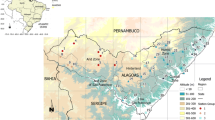Summary
The annual variation of rainfall at 131 stations distributed all over Central America is subjected to harmonic analysis. Maps present the total variance of the mean monthly rainfall, the percentage variance of the first three harmonics, the residual contributed by the higher harmonics, the amplitudes and phase angles of the first three harmonics, and the ratio of the amplitudes of the first to te second harmonics. Annual rainfall curves are in most areas adequately reproduced by the first three harmonics.
The various maps illustrate the marked regional contrasts between the Caribbean and the Pacific sides of the Isthmus and portray in particular the regional distribution of the secondary precipitation minimum around the middle of the rainy season. This quantitative description supplements an earlier study of rainfall distribution and regime in Central America.
Zusammenfassung
Der Jahresgang des Niederschlags an 131 Stationen in den verschiedenen Gebieten Mittelamerikas wird harmonisch analysiert. Die gesamte Varianz des mittleren Monatsniederschlags, der prozentuale Anteil der drei ersten harmonischen Komponenten, die den höheren harmonischen Komponenten zukommende Restvarianz, die Amplituden und Phasenwinkel der drei ersten harmonischen Komponenten sowie der Quotient der Amplitude der ersten zur zweiten Harmonischen, werden kartographisch dargestellt. Der Jahresgang des Niederschlags wird in den meisten Gebieten in befriedigender Weise durch die drei ersten Glieder dargestellt.
Die verschiedenen Karten veranschaulichen die ausgeprägten regionalen Gegensätze zwischen der Karibischen und Pazifischen Seite des Isthmus und geben vor allem die räumliche Ausdehnung des sekundären Niederschlagsminimums um die Mitte der Regenzeit wieder. Die vorliegende quantitative Beschreibung ergänzt eine frühere Untersuchung über Niederschlagsverteilung und Regime in Mittelamerika.
Résumé
On soumet à une analyse harmonique la courbe annuelle des précipitations de 131 stations d'observation situées dans les différentes régions de l'Amérique Centrale. On a ainsi établi des cartes représentant les éléments suivants: la variance totale des précipitations mensuelles moyennes, le taux que représentent les trois premières composantes harmoniques, la variance restant c'est à dire celle qui provient des harmoniques supérieures, l'amplitude et l'angle de phase des trois premières composantes harmoniques, enfin, le quotient de la première à la seconde harmonique. Dans la plupart des régions, l'évolution annuelle des précipitations est exprimée de façon satisfaisante par les trois premiers éléments.
Les différentes cartes démontrent de façon péremptoire les contrastes typiquement régionaux existant entre les côtes atlantique et pacifique de l'isthme et indiquent surtout l'extension du minimum secondaire des précipitations au milieu de la saison des pluies. Cette description quantitive complète une recherche précédente sur la répartition et les régimes de précipitations en Amérique Centrale.
Similar content being viewed by others
References
Agricultural Department of British Honduras: Monthly Rainfall Returns. Central Farm, British Honduras (1961).
Conrad, V., andL. W. Pollak: Methods in Climatology. Cambridge, Mass., 1950.
Dirección de Estadística y Censo, Panamá: Estadistica Panameña, año 1963, Serie L, Meteorologia, Panama, 1964.
Fitzpatrick, E.: Seasonal Distribution of Rainfall in Australia Analised by Fourier Methods. Archiv Met. Geoph. Biokl., B,13, 270–285 (1964).
Fitzpatrick, E., D. Hart, andH. C. Brookfield: Rainfall Seasonality in the Tropical Southwest Pacific. Erdkunde,20, 181–194 (1966).
Hastenrath, S.: Rainfall Dristribution and Regime in Central America. Archiv Met. Geoph. Biokl., B,15, 201–241 (1967).
Horn, L., andR. Bryson: Harmonic Analysis of the Annual March of Precipitation over the United States. Anals Assoc. Amer. Geogr.50, 157–171 (1960).
Lettau, K., andF. White: Fourier Analysis of India Rainfall. Indian J. Meteor. Geophys.15, 27–38 (1964).
Panofsky H., andG. W. Brier: Some Applications of Statistics to Meteorology. University Park, Pa., 1958.
Sabbagh, M. E., andR. Bryson: Aspects of the Precipitation Climatology of Canada Investigated by the Method of Harmonic Analysis. Annals Assoc. Amer. Geogr.,52, 426–440 (1962).
Servicio Meteorológico Nacional de Costa Rica: Boletín meteorológico, año 1960. San José, Costa Rica, 1961.
Servicio Meteorológico Nacional de El Salvador: Almanaque Salvadoreño 1963. San Salvador, 1962.
Servicio Meteorológico Nacional de Hondruras: Almanaque Hondureño. Tegucigalpa, Honduras, 1962.
Steinhauser, F.: Über den Tagesgang des Niederschlags. Archiv Met. Geoph. Biokl. B,14, 1–35 (1966).
Wernstedt, F.: World Climatic Data, Latin America and the Caribbean. Pennsylvania State University, 1961.
Author information
Authors and Affiliations
Additional information
With 13 Figures
Rights and permissions
About this article
Cite this article
Hastenrath, S.L. Fourier analysis of Central American rainfall. Arch. Met. Geoph. Biokl. B. 16, 81–94 (1968). https://doi.org/10.1007/BF02248868
Received:
Issue Date:
DOI: https://doi.org/10.1007/BF02248868




